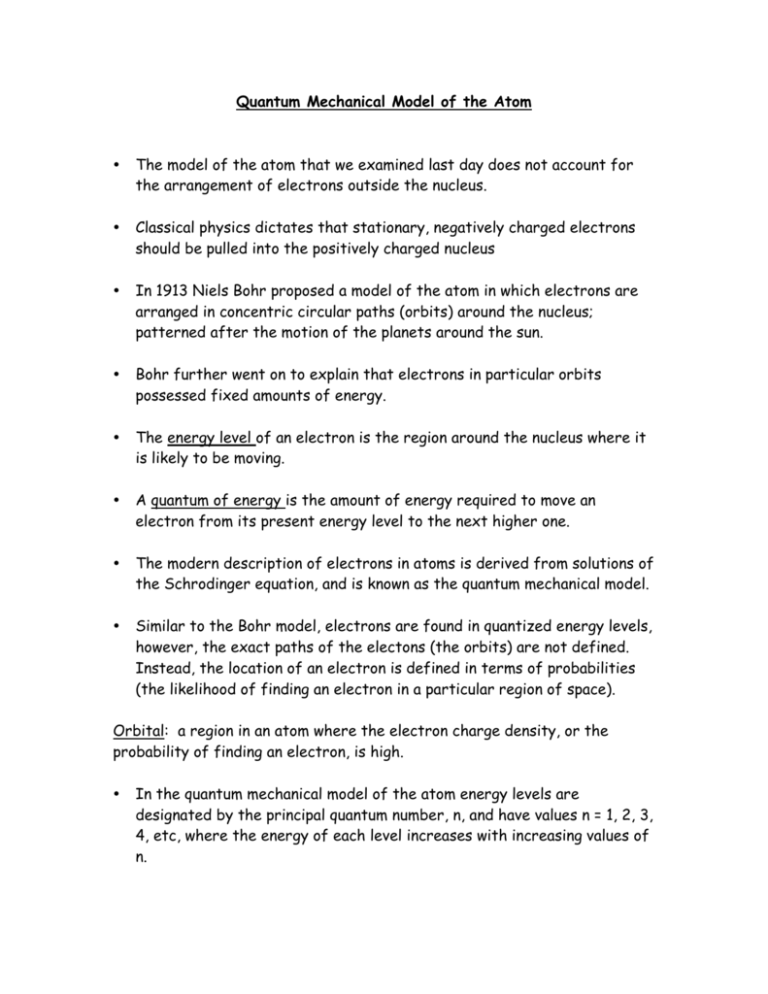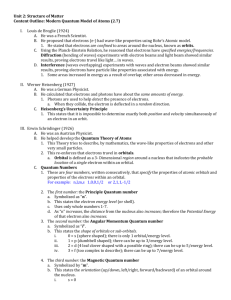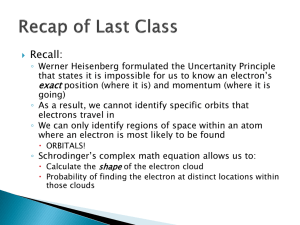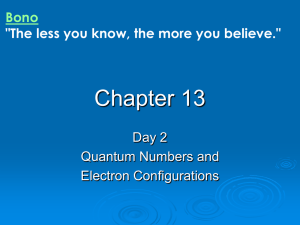Quantum Mechanical Model of the Atom
advertisement

Quantum Mechanical Model of the Atom The model of the atom that we examined last day does not account for the arrangement of electrons outside the nucleus. Classical physics dictates that stationary, negatively charged electrons should be pulled into the positively charged nucleus In 1913 Niels Bohr proposed a model of the atom in which electrons are arranged in concentric circular paths (orbits) around the nucleus; patterned after the motion of the planets around the sun. Bohr further went on to explain that electrons in particular orbits possessed fixed amounts of energy. The energy level of an electron is the region around the nucleus where it is likely to be moving. A quantum of energy is the amount of energy required to move an electron from its present energy level to the next higher one. The modern description of electrons in atoms is derived from solutions of the Schrodinger equation, and is known as the quantum mechanical model. Similar to the Bohr model, electrons are found in quantized energy levels, however, the exact paths of the electons (the orbits) are not defined. Instead, the location of an electron is defined in terms of probabilities (the likelihood of finding an electron in a particular region of space). Orbital: a region in an atom where the electron charge density, or the probability of finding an electron, is high. In the quantum mechanical model of the atom energy levels are designated by the principal quantum number, n, and have values n = 1, 2, 3, 4, etc, where the energy of each level increases with increasing values of n. The quantum mechanical model further divides each energy level into sublevels, or orbitals. Orbitals are given by both the principal quantum number (the energy level), and the letter representing the sub-level (s, p, d, f, etc) Nodes: region in which the probability of finding an electron is zero. s-orbital: every energy level contains one s-orbital. An s-orbital is a spherical region of space, centred at the nucleus, where there is a high probability of finding an electron. An s-orbital can hold up to two electrons. p-orbital: every energy level with n 2 contains 3 p-orbitals. A p-orbital is a dumbbell-shaped region of space where there is a high probability of find an electron. Each p-orbital can hold up to two electrons, hence for each energy level, with n 2, a total of 6 electrons can be found in p-orbitals. d-orbital: every energy level with n 3 contains 5 d-orbitals. Each d-orbital can hold up to two electrons, hence for each energy level, with n 3, a total of 10 electrons can be found in d-orbitals. f-orbital: every energy level with n 4 contains 7 f-orbitals. Each f-orbital can hold up to two electrons, hence for each energy level, with n 4, a total of 14 electrons can be found in f-orbitals. To see a representation of forbitals visit: www.uky.edu/~holler/html/orbitals_2.html Summary of Principal Energy Levels, Sublevels and Orbitals Principal Energy Level Maximum Number of Electrons Allowed Number of Sublevels Type of Sublevel n=1 2 1 1s (1 orbital) n=2 8 2 2s (1 orbital), 2p (3 orbitals) n=3 18 3 3s (1 orbital), 3p (3 orbitals), 3d (5 orbitals) n=4 32 4 4s (1 orbital), 4p (3 orbitals), 4d (5 orbitals), 4f (7 orbitals) Electron Configuration The way in which the electrons are arranged around the nucleus is the electron configuration. The way the electrons fill atomic orbitals (attain their electron configuration) is dictated by three rules. 1. The Aufbau Principle: Electrons enter orbital of lower energy first. Within an energy level, the s-orbital is always of lowest energy. Sometimes there is overlap of high energy orbitals in one energy level with low energy orbital in the next energy level. The diagonal rule can be used to determine filling order. 2. The Pauli Exclusion Principle: An atomic orbital may describe at most two electrons. A quantum property of electrons is spin (clockwise or counter clockwise). Electrons occupying the same orbital must have opposite spins. 3. Hund’s Rule: When electrons occupy orbital of equal energy, one electron enters each orbital until all the orbitals contain one electron with parallel spins. Example - Electron Configuration for Some Selected Elements Valence Electrons: electrons in the electronic shell of highest principal quantum number. That is, electrons in the outermost shell. PERIODIC TABLE Structure of the Periodic Table Elements in the Periodic Table are arranged according to increasing atomic number. The horizontal rows are called periods. There are seven periods on the Periodic Table. The vertical columns are called groups, or families. Elements in the same group exhibit similar properties. Group IA through VIIIA are called Main Group elements Group IB through VIIIB are called Transition Metal elements The two rows of elements placed below the main part of the table are called Lanthanides and Actinides Groups IA are the Alkali Metals Group IIA are the Alkaline Earth Metals Groups VIIA are the Halogens Group VIIIA are the Noble Gases The electronic configuration of any element can be determined quickly by using the Periodic Table, as illustrated below. Each period number corresponds to the principal energy level. The number of electrons in a partially filled sublevel can be determined by counting from left to right across a sublevel. For the transition metals, electrons are added to a d-orbital with a principal quantum number one less than that of the period number. For the lantanides and actinides, electrons are added to an f-orbital with a principal quantum number two less than that of the period number.







